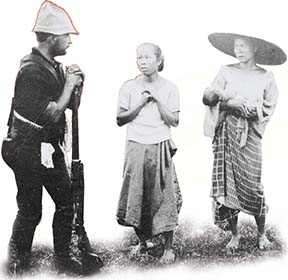SECTION 3: The United States and East Asia

▲ An American soldier and two Filipino women
WITNESS HISTORY  AUDIO
AUDIO
A Plea for Peace
Sixto Lopez, a leading Filipino spokesman, wrote to President McKinley to express his disapproval of America’s decision to keep control of the Philippines. When he wrote the letter, many Filipinos had already taken up arms against the U.S. military.
“I only know that the Filipino people are asking for [what] the American people have enjoyed for more than a hundred years…. At this season of peace I plead for peace. I plead on behalf of the wife and mother whose cheeks are coursing the silent tears … on behalf of the sad little faces, too young to realize what has happened….”
—Sixto Lopez, 1900
Objectives
- Examine the causes and consequences of the Philippine insurrection.
- Analyze the effects of the Open Door Policy.
- Describe how the United States dealt with the rising power of Japan.
Terms and People
- insurrection
- guerrilla warfare
- William Howard Taft
- sphere of influence
- John Hay
- Boxer Rebellion
- Open Door Policy
- Russo-Japanese War
- “Gentlemen’s Agreement”
- Great White Fleet
NoteTaking
Reading Skill: Recognize Sequence As you read, use a timeline to trace events and developments in East Asia that tested America’s new global power.

Why It Matters America’s decision to keep the Philippines reflected a desire to expand its influence, compete with European colonial powers, and gain new trade in Asia. American leaders devised policies to open China and other Asian markets to U.S. producers. They also wanted to extend the benefits of American culture to the people of the region. Imperialism in East Asia brought greater power and wealth to Americans, but it also increased international tensions in Asia. Section Focus Question: How did the United States extend its influence in Asia?
Filipinos Rebel Against U.S. Rule
The Filipino nationalist leader Emilio Aguinaldo had thought that the United States was an ally in the Filipino struggle for independence. His forces had fought side by side with the Americans against the Spanish. However, after the United States decided to maintain possession of the Philippines, Aguinaldo grew disillusioned with America. He helped organize an insurrection, or rebellion, against U.S. rule. The rebels believed they were fighting for the same principle of self-rule that had inspired America’s colonial patriots during the American Revolution.
Guerrilla War Erupts in the Philippines
Outgunned by American troops, Filipino insurgents relied on guerrilla warfare, a form of non-traditional warfare generally involving small bands of fighters




